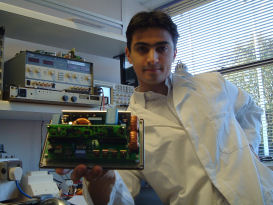New technology could enable people to generate their own power economically at home and then feed it into the national grid on a very small scale.
Cuauhtemoc Rodriguez, a PhD student here at the Department of Engineering, has come up with a new generation of cheaper and smaller inverters for solar panels which can be plugged into standard electricity sockets.
He was awarded the Millennium Medal and Prize by Dr Brian Iddon MP at a reception at the House of Commons as part of the UK National Science Week 2006 Annual Presentations by Britain's Top Younger Scientists, Engineers and Technologists. More than 150 PhD students were shortlisted to present their research results at this prestigious event. Cuauhtemoc's winning presentation was titled 'Modular Photovoltaic Systems for Embedded Generation'.
The focus of the research is on the development of new electronic systems for efficient power conversion, in particular the problem of efficiently converting solar generated power so that it can be continuously fed into the standard domestic AC electricity supply. The output power from solar panels is DC (similar to that from chemical batteries) so an electronic interface is essential to convert it into electricity at 220 - 240 V 50 Hz AC whilst controlling variations in sunshine levels. The energy output from solar panels changes continuously as the level of light varies during the day. To maintain high efficiency when the power output from the solar panels is low is particularly challenging. Most solar installations which are connected to the grid need to be at least 1kW to ensure overall system efficiency can be maintained even in low sunlight conditions.
Cuauhtemoc's research is aimed at breaking this limit while maintaining high efficiency, to allow much smaller solar installations of around 100 W, requiring much smaller capital investment, to be connected to the electricity grid. Previous devices would need at least five solar panels to work whereas this technology only requires one. The reduced size, easy connectivity and integrated conversion unit allow these solar panels to be plugged into a standard power socket in a domestic building. Instead of drawing power from the socket, power will be fed into the system. The research has the potential to change how we generate our electrical energy, giving householders the opportunity to be electric power generators as well as consumers. Electric power generation using photovoltaic cells can thus become a truly consumer-driven technology.
Professor Gehan Amaratunga, Head of Electronics, Power and Energy Conversion in the Electrical Enginering Division , said: "Cuauhtemoc has made an outstanding contribution to the development and realization of this concept, as recognized by this award. This is very pleasing for us as the panel of judges recognized the significance of the modular photovoltaic panel concept for grid connection through the use of intelligent and efficient electronics. This is a concept which we have been pioneering since 1999." The work has been supported by Enecsys, a spin out company formed by two of Professor Amaratunga's former students at the Department of Engineering, Asim Mumtaz and Lesley Chisenga, to commercialise the small scale grid-connected solar panel concept which enables modular expansion of solar generation in an 'organic' manner.
Cuauhtemoc was one of five students from University of Cambridge sponsored by the Cambridge Environmental Initiative to attend the competition, which is organised annually by the SET (Science, Engineering and Technology)organisation for Britain as part of National Science Week.


